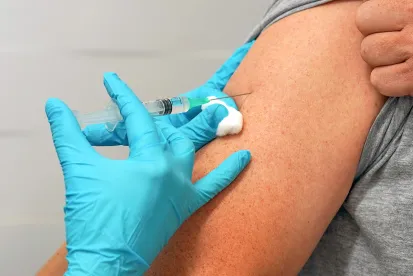More than one year after the start of the COVID-19 pandemic, wearing face masks and social distancing continue to be the “new normal.” Manufacturers, while familiar with health and safety protocols related to their operations, have had to navigate a new set of protocols aimed at maintaining a safe workplace during the global pandemic. Widespread vaccine distribution has been underway for several months and it has prompted public health authorities and governments to begin relaxing mandates and rules related to workplace safety. Many employers, including manufacturers, are now facing the challenge of maintaining a safe workplace for both vaccinated and unvaccinated individuals, in light of these changes.
On a federal level, government agencies such as the Centers for Disease Control and Prevention (CDC) and Occupational Safety and Health Administration (OSHA) have issued or deferred to new guidelines for fully-vaccinated individuals with respect to face masks, social distancing, travel, and quarantine/testing following exposure, among other things. Specifically, on May 13, 2021, the CDC issued guidance stating that fully vaccinated individuals may resume normal activities without wearing a mask or social distancing, except where federal, state, or local restrictions provide otherwise. In response, OSHA issued a statement on May 17, 2021, instructing employers to follow the CDC guidance for fully-vaccinated employees, although it has not updated its own guidance, which states that employers are prohibited from distinguishing between vaccinated and unvaccinated employees for purposes of workplace safety measures. In addition, the Equal Employment Opportunity Commission (EEOC) has taken the position that employers may generally request proof that an employee has received the COVID-19 vaccine, although local and state laws may differ on this issue. While some guidance suggests that employers may distinguish between vaccinated and unvaccinated individuals, other guidance is less clear, and there are legal risks in doing so.
In response to the CDC’s guidance, many states, including Connecticut, Massachusetts, New York, and Rhode Island, have announced that they will be lifting or limiting their mask mandates, social-distancing requirements, and other restrictions for individuals who are fully vaccinated, with some exceptions. In Connecticut, these newly-relaxed rules resulted in a host of business-related guidance being issued by the Connecticut Department of Public Health (CT DPH). For example, CT DPH recommends that employers require employees to wear a mask if they are unvaccinated or their vaccination status is unknown, and they are not able to maintain continuous separation from customers or co-workers, with some exceptions for settings in which masks are still required of all individuals (e.g., health care, etc.).
The recent changes to laws and guidance have left many employers trying to understand not only the current legal restrictions in the states in which they do business, but also their broader obligations under state and federal law to provide a safe workplace, as well as the impact that changes to policies might have on the workplace. As a preliminary matter, if state or local restrictions have been relaxed, employers may wish to determine whether they can relax the restrictions in their workplaces and still maintain a safe work environment. Such decisions may be impacted by regulations in the states in which they do business as well as the differences in law/guidance across state lines. In making that determination, it is important for employers to understand how many vaccinated/unvaccinated individuals are in the workplace; whether risks can be mitigated, including health risks to unvaccinated individuals; the anticipated employee response to relaxed restrictions, which may vary among facilities and locations; and whether the layout of the facility and its operations support changes in protocol (e.g., space available, ventilation, workstation layout, etc.), among other considerations.
Accordingly, employers will want to remain up-to-date on the changing laws and guidance and consider and evaluate the legal and human resources issues and risks associated with relaxing health and safety protocols.



 />i
/>i

